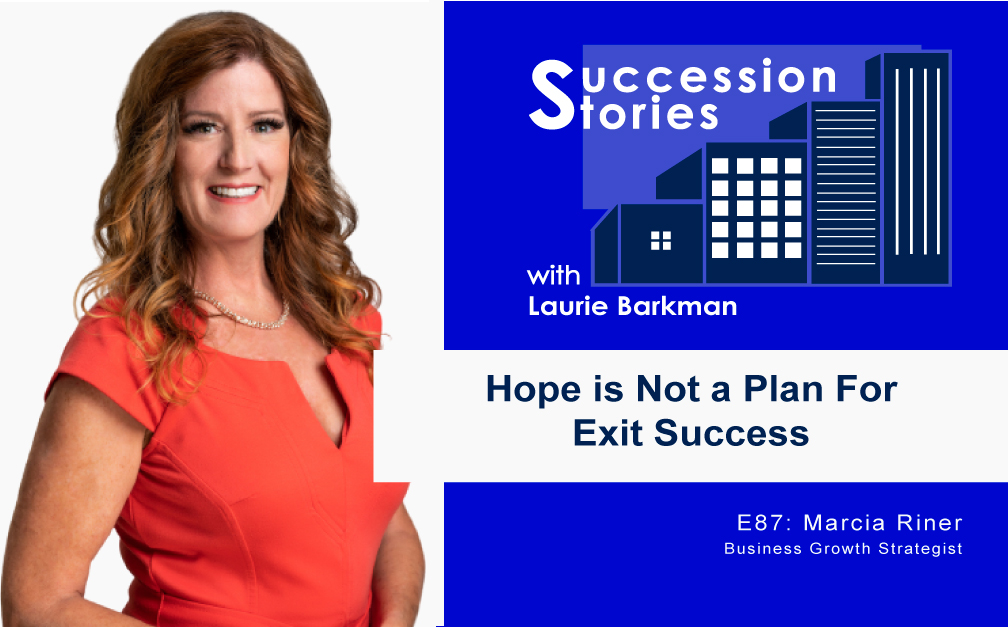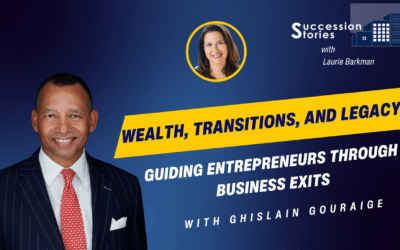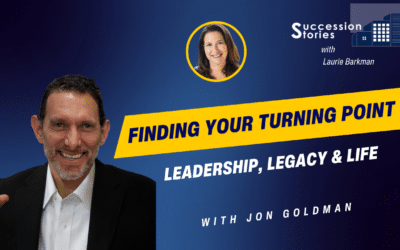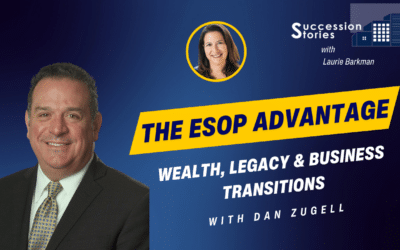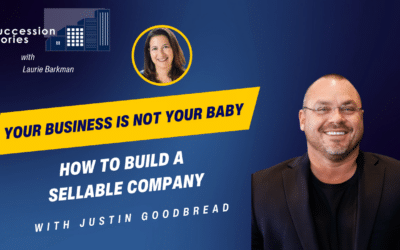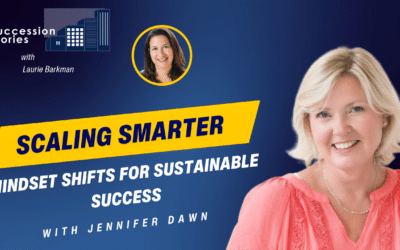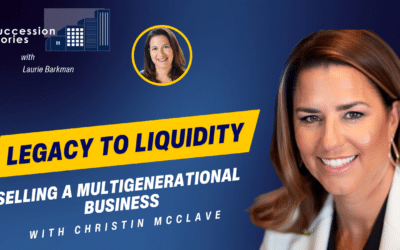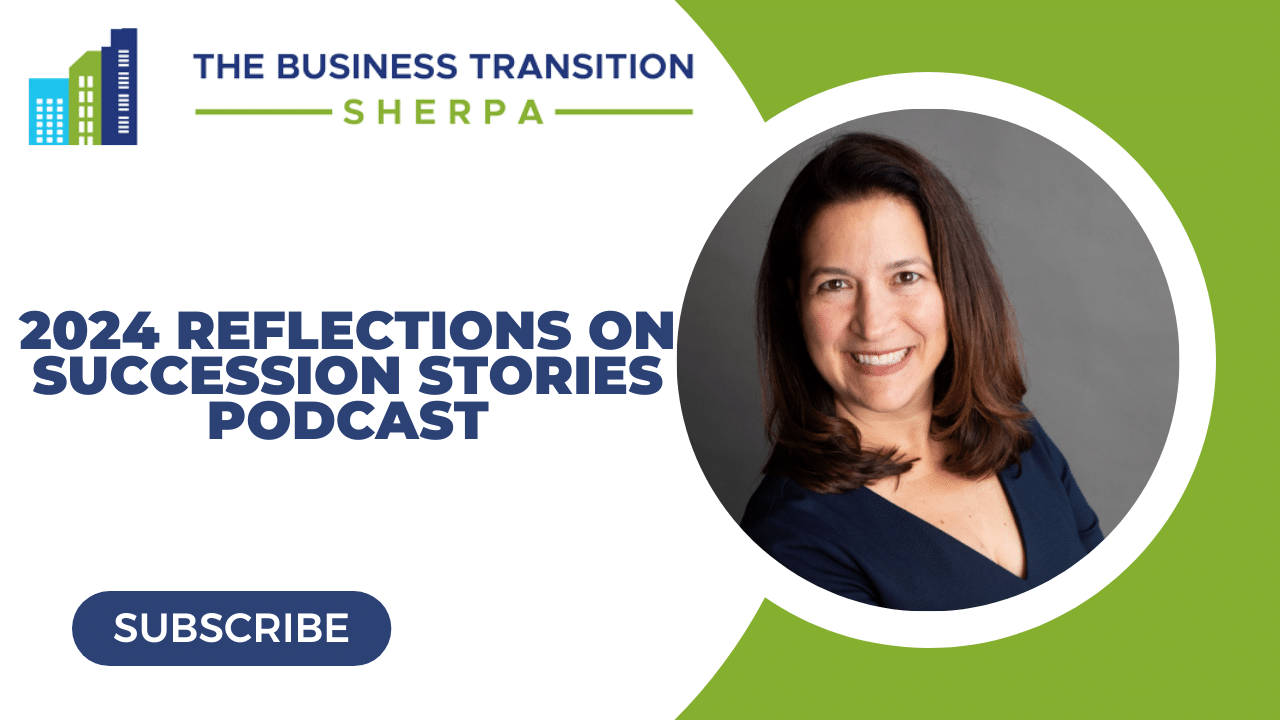How can business owners turn their biggest asset into one worth selling? Marcia Riner shares the heartbreaking experience of watching both of her parents close their businesses. Now as a business growth strategist, Marcia helps service-based professionals strengthen their business so that it is worth selling someday. She’s the author of “Big Profit Secrets” and hosts a podcast called “Profit With A Plan.” Listen in as host Laurie Barkman talks with Marcia about why it’s best to have a plan, rather than hope for exit success, on this week’s Succession Stories.
Listen in to learn more about:
- The difference between sell ready and ready to sell
- Creating a roadmap for selling your business
- Structuring your business in a way that attracts buyers
- The challenge of owner dependency
- The importance of an exit mindset
Show Links:
Laurie Barkman appearance on Profit With a Plan Podcast hosted by Marcia Riner
Jeff Ford Succession Stories E86 – How to Prepare for Sell Side Diligence
https://www.trajectorybiz.com/
About Succession Stories Podcast
Succession Stories is hosted by Laurie Barkman, the Business Transition Sherpa– guiding business owners through the process from “transition to transaction.”
Learn more at https://thebusinesstransitionsherpa.com
Book a 1:1 Advisory call at:
We appreciate your support…subscribe, share, and post a review to share what you like about the show!
Don’t leave your exit to chance.
Stony Hill Advisors works with owners like you to get ready and maximize value when you’re ready to sell.
Visit www.stonyhilladvisors.com/podcast for a complimentary business valuation.
Transcript
Laurie Barkman:
Marcia Riner is a kindred spirit. Like me, she is motivated to help business owners turn their biggest asset into one worth selling whenever they decide they want to enjoy something new. What motivates her is the heartbreaking experience of watching both of her parents close their businesses, leaving their legacy and money on the table. Many small business owners work years to build and grow their companies but have no exit plan, leaving their investment behind. Marcia advises owners how to create strong, profitable, and attractive companies that are more valuable at retirement or exit. She’s the author of “Big Profit Secrets” and hosts a weekly podcast called “Profit With A Plan.” I was recently a guest on her show, and I encourage you to give it a listen as well. Discover why hope is not a plan for exit success on this Succession Stories episode with Marcia Riner.
Laurie Barkman:
Marcia, welcome to Succession Stories. You and I are kindred spirits. We are fellow podcasters. We are both inspired to work with business owners and help make them more successful in their future transition. We are going to have an awesome conversation today. Welcome.
Marcia Riner:
Thank you so much, Laurie, I’m really excited to come on your show, and like you said, we both have the same philosophy in business, and I’m just so excited to share.
Laurie Barkman:
Thank you, and I was recently on your podcast called PROFIT With A Plan, which we definitely want everyone to check out, and I was honored to be on your show, and likewise, it’s great to have you here. Let’s start with you. Tell us a little bit about you. I think there’s an entrepreneurial gene in your family.
Marcia Riner:
Yeah, just a couple of them. I started off… I probably did the lemonade stand like everybody else did and you know, I didn’t do a paper route, but I was always thinking about how I could do something more and both my parents were business owners. Dad ran a car dealership resale very good. I gotta tell you at 16, I drove the hottest car in town and he did really well in business, but he really didn’t understand the financial stuff his company and he had more than enough money to enjoy his life, but when it came down to winding down his business and exiting, he couldn’t sell it because his books were a mess. Could he dot the i’s and cross his t’s? No. Could he make sense of where the money came in from and where the money went out to? No, so he left and was unable to sell the business and just as retiring, closed down, which broke my heart.
Similar story was with my mom, my mom ran a fantastic mortgage business started in the late 80s, ran through the 00’s and just, she ended up having at one time, eight branches all over Northern California, and created off site processes, so in the mortgage world, that means you send the account to somebody else, they process it, they go back and forth. Unheard of in that time, Washington Mutual, an old bank countrywide came to her for how she was doing it and in the late 90s, she had actually had an offer to sell. Get this: someone offered her close to a million dollars. She didn’t take it because she said, “I’m not ready to retire. I have so much more to do.” Fast forward.
Laurie Barkman:
How old was she?
Marcia Riner:
She was in her mid to late 50s. Probably mid 50s. She just thought she had more to do.
Laurie Barkman:
Yeah.
Marcia Riner:
Come rolling 2008, you all know what happened to the mortgage industry and the financial world. Well, she ended up in 2011 closing her doors with nothing left but a bunch of office equipment. Sad. So totally sad. She and my father both made great incomes during their life and saved but they left their business on the floor and if I combine the values of both of those, probably a million and a half. Right there on the floor that they left.
Laurie Barkman:
It’s sad, and they at the time, had they ever talked to you about potentially you taking over the company?
Marcia Riner:
Mom thought I would and I got in and it just wasn’t for me. It wasn’t my gig. I had worked for her and rose up in the ranks and had done things but it just wasn’t… when you’re an entrepreneur, right, you’re always looking at, “What’s the next thing I can do? What can I start, create, and develop?” and she had already developed that so it wasn’t really my gig and my ex husband dragged me all over the country after that. But what it did do for me, it gave me the insights of not having control. I didn’t have the skill set back then to help her and advise her and go, “Oh, you should have taken that. Oh, you should do this, this, this, and that to get ready for it. You don’t have to retire now,” and they probably would have kept her on as a consultant or part of the leadership team. She didn’t have to cut the cords and go sit in a rocking chair. Retirement isn’t always said and done and yeah, so it sent me on a journey too.
Laurie Barkman:
You’re a Certified Financial Planner.
Marcia Riner:
Yes.
Laurie Barkman:
Seeing their experience with the finances, as you said, your dad’s books were a mess, do you think that that’s what inspired you and your education, your career?
Marcia Riner:
Well, I was always attracted to money. One of my earlier jobs was –
Laurie Barkman:
– Who’s not? [laughs]
Marcia Riner:
All of my jobs have always been around money so that’s been an attractive one and that’s what led me into advising and the financial advising, but I wanted to help business owners. I wanted to give them tools that, gosh, none of us ever really learned in school or from our parents so we’re out there the land of hard knocks, learning the hard way and so I wanted, I started investing in myself, and investing in coaches and mentors, I got my degree in Business and Finance, I went off and took the long path to get the CFP, which is a Certified Financial Planner designation and I had a lot of licenses and a lot of credentials but it’s still, there was still that missing piece. How do you create this fantastic business now, and a retirement asset that you could sell later, because after all, we’ve put our blood sweat, tears, nights, weekends, a lot of our savings and income into this business, to just leave it on the floor, it breaks my heart.
Laurie Barkman:
Yeah, and the companies you described. One was a service business, the other with cars was a physical product, so you’ve seen both sides of that. Let’s talk about what this means and in your practice advising business owners, I think there’s a difference between sell ready and ready to sell and it’s a continuum, so let’s talk a bit about that and what that means. How do we think about the difference between sell ready and ready to sell?
Marcia Riner:
Love that differentiation. Ready to sell means, “Okay, I’m looking for somebody to help me get rid of it right and get out of it.” Sale ready means that you have a fantastic profitable business that is meeting all of my eight characteristics for an attractive business, and you’re in control of it, and whenever 10 years, five years, 20 years down the road, you are in a position to shift into that ready for sale position.
Laurie Barkman:
It does vary when someone is ready. In the case of your mom, here was a potential acquire,r she wasn’t ready. Maybe the business was, but yeah, in her mind, she wasn’t ready. There are folks who don’t do the work to work on their business. They’re working in their business every day and it’s difficult to step out and take that 10,000 foot view. I know in your practice, in your books, and what you do when you work with clients, you talk about a sell ready roadmap, I thought you might share a little bit about that roadmap, and what it takes in case someone’s thinking about these next five years, there’s a podcast, or excuse me, there’s a webinar coming up and the title of the webinar is, I think it’s from NAVIX, and they said the last five years will make or break your exit. I thought about that. Okay, so they’re putting a stake in the ground, right, they’re putting a stake in the ground, saying, “If you don’t really prepare in this last five years, it might be too late for you,” it was a little bit of a scare tactic, but there’s some truth to it, so there’s a lot to think about that, and share your views on this.
Marcia Riner:
There’s a lot of truth to it usually, because like you had mentioned, you’re busy working in the business, you’re putting out fires and chasing customers, you’re not thinking about structurally, putting that business in a position that would be very attractive to somebody else qnd there are many other other people that are companies that would like to buy, you’ve got, there’s always the junior succession plan, right? Somebody coming in taking over, you definitely don’t want to give the business to them, but you want to make it in a way that they can afford to continue to pay you, then you’ve got the partner, maybe it’s a future partner coming in or employee or a team of employees that take over the business for you. Again, you want that business strong enough to have them be able to make their salary and pay you during that time. Then the most common is always the competition someone coming in to acquire your clients, your methodology, your ideas that you have, and they’re coming in at often maybe a little bit of a discounted price, they may come in and restructure and do things and then the fourth type of buyer out there that I’m aware of, or I think of is that person and especially in the professional service world. There’s that person that just wants to avoid the ramp up the startup phase and has a little money in their pocket and are willing to pay to take over an active business.
All of that, those businesses have different variations of what would be a strength to the buyer but in my eight factors, I think all of those really, truly stand strong for any buyer, and give you the flexibility that there could be multiple types of buyers that are going to buy your business whenever that is but in order to get there, you have to have a plan. You know the old saying, hope is not a plan, right, you can’t hope for something to be there, you have to have a strategy laid out and then you actually have to have action in execution on that plan to be able to get you into that position that’s ready and that’s really what the sale ready mindset does, is it’s putting that plan in that if you want to be here, whenever here is and whatever here looks like, you have to go back to the starting and make that move up to it and that usually doesn’t happen overnight.
Laurie Barkman:
No, absolutely not and when time is on your side, you have more opportunity to make changes.
Marcia Riner:
100%.
Laurie Barkman:
Let’s talk a little bit about professional services. You mentioned them as a focus area. Is that a core industry group that you work with?
Marcia Riner:
Yeah, it’s an area where I think it’s completely underserved and the biggest challenge that they’re facing is one of my eight factors is the owner dependency, so that owner is the business right? They often name themselves that, they’re in there swinging the hammer or doing the books or providing the service. They’re the rainmaker of that business and one of the biggest challenges that they have is that they’re so involved in that business that it’s difficult to be able to sell or transition later on for them and so the strategy and the plan to get them to think like a big business, instead of like them doing the phone calls and being the Rainmaker. It really gets them in a position that they can have the time off that they want and the lifestyle that they dreamed of when they came around having a business. I mean, we’ve all been that, right, “Oh, I want to go to Bobby’s baseball game on Thursday afternoon, I want to have the laptop lifestyle and travel all over the world.” Well, it doesn’t happen when you’re that business and therefore you have to have systems and processes and people to allow you to step away from the day to day operations, and become the CEO or leader and not the technician, as Michael Gerber says.
Laurie Barkman:
I just talked with an attorney this morning, his firm got acquired last December, and they’re still going through the integration but the firm that acquired them is a lot larger, significantly larger and we were talking about his transition with that he and his team, they wanted to stay together and that was a key aspect of in their decision process of who was the right fit, so they largely retained all the lawyers and staff and they just sort of set up the shingle underneath a different roof or with a different roof, I guess, and I said to him, “Okay, so now you’re not running the business anymore. You’re doing what you love, which is being an attorney, and you don’t have to worry about payroll,” and he said, “You can’t even imagine,” it’s just a whole other aspect of relief.
I know we’re talking about the sale and maybe contemplating that the owner isn’t there anymore but there certainly are scenarios where the owner stays on, and continues to be part of the business and in a different way. Whether it’s because of an earn out or whether it’s because of an employment agreement that they’re committed for a certain period of time or in this situation with the attorney it’s indefinite. They want to stay on, they want to, they’re not ready to retire yet. I think he’s in his 50s and he’s got some more energy to keep going so I don’t really want to presume and the sale is to retire.
Marcia Riner:
Right. Just like my mother, she could have stayed on and structured the deal to have her still be part of the company so yeah, I think that that is really important, that the owner think about even when they’re planning what happens after, “What’s my life look like after,” it’s not a rocking chair. It may be philanthropy. It may be starting a new company, supporting the company, there’s so many things but that’s part of your plan is to know what it looks like on the other side.
Laurie Barkman:
Where do people start, when you connect with a business owner, entrepreneur, and what’s your process? How do you talk to someone who’s just thinking about it, but it’s not urgent yet? Stephen Covey’s pastime is urgent and the non urgent and the important, not important. This is clearly at this point, let’s say in the five years out range. It’s important. How do we say, “This is where you need to be, this is how you need to get started.”?
Marcia Riner:
Yeah. Again, I start with that sale ready roadmap that we had spoken of earlier. It’s not the act of sale, but it’s preparing for it, and my process is simple. There’s really just four areas I work on and the first part of that is the dream vision, right, so where do you want to be? What does that look like? What’s the value you’re hoping to get? What’s your plan for you and your employees? Let’s draw and dream out everything, the ideal situation you want. Who might you want to take over? So when we create that future vision, we can start to see where we want to go then the counter opposite of that is, where are you today? We like to figure out, what have you got going on? What are your strengths and weaknesses? Are your financials clean? Do you have positive increasing cash flow? How involved is the owner? Because nobody wants to buy your headache, and we go through our checklist as to, what is your company today, and where could we improve that. Then we start looking at that third section: how do we bridge the gaps, right? How do we get you from here to there? We lay out the ideas that you have, and the holes that you may not see.
For many of us working in our business, it’s difficult to see what is the forest through the trees? I think I said that right, the trees through the forest that you can’t see things because you’re too deep end so when you have somebody that comes in, like you and I and can look at that business, we’re often able to see the things that you can’t. Then the fourth strategy, or the fourth part of that is, and I love this coin, I stole it from somebody, ‘action takers are moneymakers’, so now here comes the action and the first thing we do is we create the strategy. We develop the tactics, we go ahead and we put the plan in place, and then finally we take action, and action could take a long time to execute, but the planning is usually done in a short period of time.
Laurie Barkman:
Absolutely. That’s a great roadmap, because it’s very logical, and it’s easy to understand. It’s hard to do, though. That’s the bottom line, like our summary of four steps can take a really long time. How long does it take? Well, it depends.
Marcia Riner:
Yeah, and how much time do you have?
Laurie Barkman:
There’s a funny visual, I think it’s funny, so Jeff Ford is a partner at Grossman Yannick and Ford, which is a accounting firm, they do valuations, and he and I had a great conversation on episode before yours so I’ll put a link to that in the show notes if anyone wants to listen to it, but one of the funny things that he had said, was, “Well, to answer that question, it really depends on your starting point as to how much time it’s going to take and what you need to work on,” and he said, “It’s just like, well, how fit are you from an athletic standpoint or weight loss standpoint,” and I just couldn’t get it out of my head, you got Arnold Schwarzenegger in like the 1970s as one visual, and then you’ve got you know, today with the show My 1000 Pound Life and so again, it really just depends on what starting point you have, but the roadmap that you’ve laid out, it makes a lot of a lot of sense and I see that too, with my clients, and – go ahead.
Marcia Riner:
Like you just mentioned, the perfect in shape and the perfect not in shape your business can be you know, somewhere in between and like you had mentioned earlier in the show that the runway you have, time is your best component to this. The more time you have, the less stress it is to develop the plan, the more time to execute the plan so you ideally, always my thought is start from day one, thinking how you’re going to get out at the end because when you do that everything that you’re doing is evolving to how eventually you’re going to get out, so it’s never ever too early to start.
Laurie Barkman:
Absolutely. I ask all of my guests, Marcia, if they have a favorite quote, and I’m sure you have many, but if there was one that you wanted to share, what would it be?
Marcia Riner:
Well, I think I just said it, it’s Stephen Covey’s, ‘start with the end in mind’, and the earlier you start, the better off you’ll be so I think that’s the simpler one. Now I have my fun quotes, but I think appropriately and really, truly, that’s a core value in my company and what I hope to share with my clients is to start with the end in mind in every decision you make is going towards how you’d like to exit and get that investment back.
Laurie Barkman:
Yeah, absolutely and on that note, if people want to get in touch with you to learn more, and I know you have a lot of resources that they can tap into, so if you want to just share/mention a couple of those.
Marcia Riner:
Thank you. As you mentioned earlier, my podcast is called PROFIT With A Plan. I’ve been going for a few years now and we talk and share ideas just like you do. We’re a resource for our listeners to be able to go, “Oh, I didn’t think about that,” or, “Oh, that’s what I need to put into my business,” because we can’t put it all in at once. PROFIT With A Plan is up on YouTube and it has sound through profitwithaplan.com and then as always, you can find any of the information in any links at my company Trajectory Consulting, and that’s trajectorybiz.com.
Laurie Barkman:
We’ll have the social links for everyone in the show notes. Marcia, if you were going to leave us with one piece of advice, what would it be?
Marcia Riner:
I think the biggest thing that I would recommend to all of your listeners is to put a plan together, right, don’t go back on hoping that your business will be worth something later down the road, and that you’ll get all the value that you want, and it’ll be an easy transition. It won’t. Put a plan together, start thinking through the areas that maybe you can improve on. The huge benefit about doing it now is it makes a great business now and a retirement asset later.
Laurie Barkman:
Thanks so much for coming on the show, and we will talk again soon. I’m very sure.
Marcia Riner:
Thank you.
Laurie Barkman:
My objective is for you to have a lucrative and successful succession. If you want to understand the value of your company today, the potential net proceeds of a transaction, and your financial needs after you leave the business, that’s a great place to start. The sooner you understand these numbers, the more time you’ll have to close the gap, if there is one.
Take the next step by requesting an initial meeting to begin planning for your business transition and strategic exit today. Request a call with me at meetlauriebarkman.com

